Linear Drum Set World Rhythms
- SYNKD Admin

- Aug 30, 2019
- 2 min read
This lesson is to be used in conjunction with the “World Rhythms” rhythm pack available in the SYNKD store.

This lesson is focused on reinterpreting some common world rhythms into a contemporary setting. For our purpose we will be dealing with a linear application. For those unfamiliar with what linear drumming is, it is simply where no two limbs are ever playing at the same time.
Please notice that I have outlined where the world rhythm is in each pattern by a bold and capitalized letter. This doesn’t mean that you are to accent these notes- it’s just so you can see how the rhythm is being interpreted.
Exercises 1 and 2 are built around the 2:3 Rhumba clave, notice that we're using the alternate notation using one bar of 16th notes as opposed to two bars of eighth notes.

Exercise 1 has the clave being played in the right hand. Pay attention to the snare and bass drum patterns and interplay of everything.

Exercise 2 is just a variation of the previous. Once you’re comfortable with each bar
individually, try combining them into a two bar phrase.

Exercises 3 and 4 are built around the 3:2 Rhumba Clave, once again I opted for the alternate notation.

In both these examples the clave is played own the bass drum. Example 4 is also a great ghost note exercise.

Exercise 5 and 6 are built around the 2:3 Son Clave (Alternate Notation) which will be played on the snare drum.


Exercise 7 deals with the Baio and it is played in the feet. Notice that both the hi-hat and bass drum are being played. This makes for a great balance exercise.


Exercise 8 uses the 3:2 Son Clave (Alternate Notation). Notice that the rhythm is now spread out across different voices. This is a very melodic pattern.


Exercises 9 and 10 are variations of Exercises 1 and 2. This time we are doubling up notes to great a Steve Gadd-esque 32nd note groove.




Comments